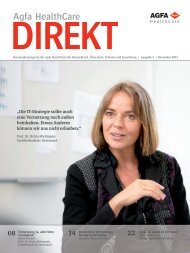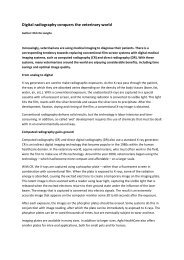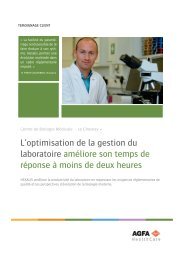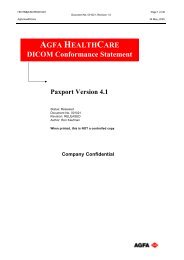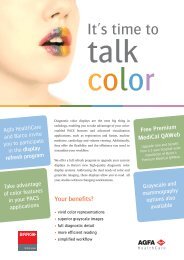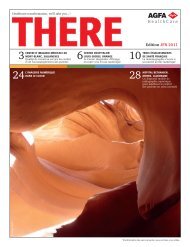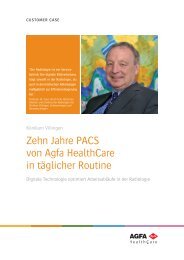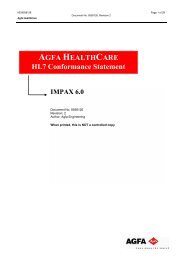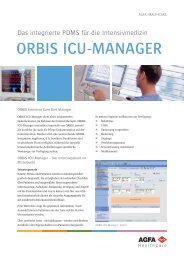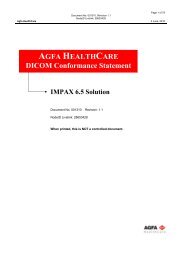Edition 4 - Agfa HealthCare
Edition 4 - Agfa HealthCare
Edition 4 - Agfa HealthCare
You also want an ePaper? Increase the reach of your titles
YUMPU automatically turns print PDFs into web optimized ePapers that Google loves.
›››<br />
23 to 37. At the same time, we were<br />
awarded 80% of the projects in Colombia<br />
and Brazil from leading institutions.<br />
In the Middle East, the adaptation of<br />
healthcare IT solutions is advancing, and<br />
we have grown from 13 customers in<br />
2007 to 31 – and counting. Most of these<br />
institutions have established regional<br />
healthcare networks to serve vast<br />
geographical areas ranging from one half<br />
to a million patient visits annually.”<br />
“In Asia, we recently implemented<br />
our advanced HeartStation ECG<br />
Management System, which automates<br />
the processing and storage of<br />
electrocardiograms, at the renowned<br />
Singapore Heart Institute. This facility,<br />
which performs 75,000 cardiac<br />
investigative procedures and 1,700<br />
surgical operations each year, is the<br />
only institution in Singapore with heart<br />
and lung transplant programs.”<br />
Where does the future lead for<br />
<strong>Agfa</strong> <strong>HealthCare</strong><br />
“We will continue to support<br />
our customers in the ever-evolving<br />
challenges of healthcare. Our strength<br />
lies in our solid understanding of the<br />
healthcare market: with our extensive<br />
history in imaging and IT, we can<br />
deliver solutions that meet the needs of<br />
our customers head-on. But of course<br />
this evaluation is not up to us alone.<br />
The success of our systems and the<br />
satisfaction of our customers are the<br />
best measurements of our ability to<br />
deliver solutions for a global healthcare<br />
population. The rapid growth of our<br />
installed base in Europe, Asia, Latin<br />
America, the US, Africa, and the Middle<br />
East is a reflection of that success.” •<br />
Delivering solutions in an<br />
increasingly complex environment<br />
Interview with Dr. Christian Herold, Chairman of the Department of Radiology, Medical University of Vienna<br />
The workload of clinicians is<br />
increasing. How can healthcare IT<br />
vendors support their users to meet<br />
this challenge<br />
“The introduction of RIS/PACS<br />
has been instrumental in many ways<br />
in enabling clinicians to manage their<br />
increasing workloads. One of the<br />
main principles of RIS/PACS design<br />
is that it engineers workflows to help<br />
users focus on their core tasks, and as<br />
a result improve service and patient<br />
care. This is achieved by automating<br />
repetitive and often time-consuming<br />
tasks and by giving the physician<br />
access to the right information at the<br />
right time. In my specific case, we<br />
have seen an exponential growth in<br />
diagnostic images during the past five<br />
years. This would have been a real<br />
challenge without the necessary tools<br />
and solutions at hand. For example,<br />
introducing a workflow driver supports<br />
physicians by automatically managing<br />
their workloads and ensuring that the<br />
preconditions to start the task are met.<br />
They can then deliver more efficient and<br />
effective care.”<br />
“With regards to the future, the<br />
step-by-step introduction of even<br />
more intelligent hanging protocols,<br />
which combine automated image<br />
rendering such as MPR with image<br />
organization, image presentation<br />
states and server based rendering, will<br />
transform the way in which we work.<br />
It will allow us to fully focus on the<br />
tasks themselves rather than the task<br />
preparation.”<br />
Prof. Christian J. Herold,<br />
M.D., is Chairman of<br />
the Department of<br />
Radiology at the Medical<br />
University of Vienna<br />
(Austria) and part-time<br />
faculty member at the<br />
Johns Hopkins Medical<br />
Institution’s Department<br />
of Radiology in Baltimore<br />
(USA). Dr. Herold is<br />
the President of the<br />
European Society of<br />
Radiology (2008/2009).<br />
RIS and PACS are key drivers in the<br />
workflow of imaging departments.<br />
How can healthcare IT vendors further<br />
extend the value of these applications<br />
“The workflow in a clinical practice<br />
is often a combination of serial and<br />
parallel tasks that are executed based on<br />
patient care and business criteria. This<br />
concept is ideal for workflow modeling<br />
but is not addressed in most RIS/PACS<br />
solutions today. RIS and PACS have to<br />
evolve and introduce tools that enable<br />
automation in persona-based workflows.<br />
Another important function will be<br />
assigning workflow-related tasks to the<br />
different stakeholders (radiologists,<br />
clinicians, technologists, secretaries)<br />
based on an integrated HIS/RIS solution<br />
connecting to PACS. This will truly<br />
benefit clinical practices as well as<br />
individual practitioners. <strong>Agfa</strong> <strong>HealthCare</strong><br />
clearly recognizes this.”<br />
Today, customers are often challenged<br />
by the amount of services necessary to<br />
support their products. What do you<br />
expect with regards to servicing<br />
“Flexibility and standardization<br />
are key requirements for keeping<br />
the servicing needs of any solution<br />
to a minimum, while ensuring quick<br />
and efficient service when needed.<br />
The more flexible a solution, the<br />
more it can be managed; the more it<br />
adheres to certain standards, the easier<br />
it can be supported. Customers want<br />
vendors to deliver solutions that meet<br />
these expectations and requirements<br />
up front, which enables a better<br />
service after installation. With its<br />
strong focus on healthcare IT,<br />
<strong>Agfa</strong> <strong>HealthCare</strong> has made this<br />
a priority, while simultaneously<br />
ensuring that the individual needs of<br />
its customers are met, for example<br />
through the ability to customize.”<br />
“Today and in the near future,<br />
the challenge for healthcare IT vendors<br />
will be to ensure they can continue<br />
to deliver optimal service in an<br />
increasingly complex environment.<br />
Furthermore, they will have to manage<br />
such interventions without affecting<br />
the work of the end-user.” •<br />
THERE 7



